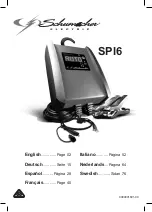
ELECTRICAL - 2B-3
90-852396 MAY 1996
SPECIFIC GRAVITY CELL
COMPARISON TEST
This test may be used when an instrumental tester is
not available. To perform this test, measure specific
gravity of each cell, regardless of state of charge, and
interpret results as follows: If specific gravity read-
ings show a difference between highest and lowest
cell of .050 (50 points) or more, battery is defective
and should be replaced.
Electrolyte Level
Check electrolyte level in battery regularly. A battery
in use in hot weather should be checked more fre-
quently because of more rapid loss of water. If elec-
trolyte level is found to be low, then distilled water
should be added to each cell until liquid level rises ap-
prox. 3/16
in.
(4.8mm) over plate. DO NOT OVER-
FILL, because this will cause loss of electrolyte and
result in poor performance, short life and excessive
corrosion.
CAUTION
During service, only distilled water should be
added to the battery, not electrolyte.
Liquid level in cells should never be allowed to drop
below top of plates, as portion of plates exposed to
air may be permanently damaged with a resulting
loss in performance.
Charging a Discharged
Battery
The following basic rules apply to any battery charg-
ing situation:
1. Any battery may be charged at any rate (in am-
peres) or as long as spewing of electrolyte (from
violent gassing) does not occur and for as long as
electrolyte temperature does not exceed 125
°
F
(52
°
C). If spewing of electrolyte occurs, or if elec-
trolyte temperature exceeds 125
°
F, charging
rate (in amperes) must be reduced or temporarily
halted to avoid damage to the battery.
2. Battery is fully charged when, over a 2-hour peri-
od at a low charging rate (in amperes), all cells
are gassing freely (not spewing liquid electro-
lyte), and no change in specific gravity occurs.
Full charge specific gravity is 1.260-1.275, cor-
rected for electrolyte temperature with electrolyte
level at 3/16
in.
(4.8mm) over plate, unless elec-
trolyte loss has occurred (from age or over-filling)
in which case specific gravity reading will be low-
er. For most satisfactory charging, lower charg-
ing rates in amperes are recommended.
3. If, after prolonged charging, specific gravity of at
least 1.230 on all cells cannot be reached, battery
is not in optimum condition and will not provide
optimum performance; however, it may continue
to provide additional service, if it has performed
satisfactorily in the past.
4. To check battery voltage while cranking engine
with electric starting motor, place RED (+) lead of
tester on POSITIVE (+) battery terminal and
BLACK (-) lead of tester on NEGATIVE (-) battery
terminal. If the voltage drops below 9-1/2 volts
while cranking, the battery is weak and should be
recharged or replaced.






































